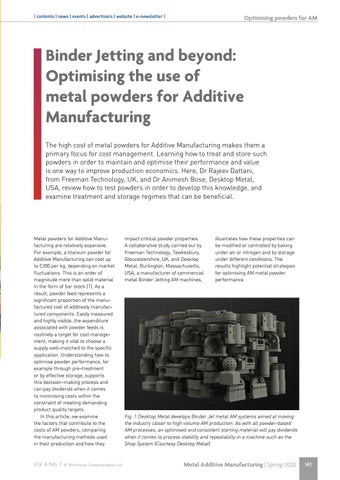| contents | news | events | advertisers | website | e-newsletter |
Optimising powders for AM
Binder Jetting and beyond: Optimising the use of metal powders for Additive Manufacturing The high cost of metal powders for Additive Manufacturing makes them a primary focus for cost management. Learning how to treat and store such powders in order to maintain and optimise their performance and value is one way to improve production economics. Here, Dr Rajeev Dattani, from Freeman Technology, UK, and Dr Animesh Bose, Desktop Metal, USA, review how to test powders in order to develop this knowledge, and examine treatment and storage regimes that can be beneficial.
Metal powders for Additive Manufacturing are relatively expensive. For example, a titanium powder for Additive Manufacturing can cost up to ÂŁ200 per kg, depending on market fluctuations. This is an order of magnitude more than solid material in the form of bar stock [1]. As a result, powder feed represents a significant proportion of the manufactured cost of additively manufactured components. Easily measured and highly visible, the expenditure associated with powder feeds is routinely a target for cost management, making it vital to choose a supply well-matched to the specific application. Understanding how to optimise powder performance, for example through pre-treatment or by effective storage, supports this decision-making process and can pay dividends when it comes to minimising costs within the constraint of meeting demanding product quality targets. In this article, we examine the factors that contribute to the costs of AM powders, comparing the manufacturing methods used in their production and how they
Vol. 6 No. 1 Š 2020 Inovar Communications Ltd
impact critical powder properties. A collaborative study carried out by Freeman Technology, Tewkesbury, Gloucestershire, UK, and Desktop Metal, Burlington, Massachusetts, USA, a manufacturer of commercial metal Binder Jetting AM machines,
illustrates how these properties can be modified or controlled by baking under air or nitrogen and by storage under different conditions. The results highlight potential strategies for optimising AM metal powder performance.
Fig. 1 Desktop Metal develops Binder Jet metal AM systems aimed at moving the industry closer to high volume AM production. As with all powder-based AM processes, an optimised and consistent starting material will pay dividends when it comes to process stability and repeatabilty in a machine such as the Shop System (Courtesy Desktop Metal)
Metal Additive Manufacturing | Spring 2020
143
